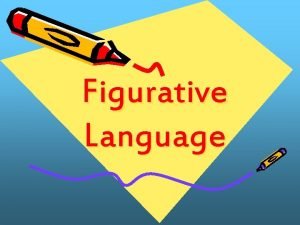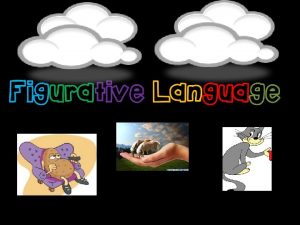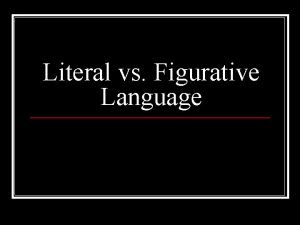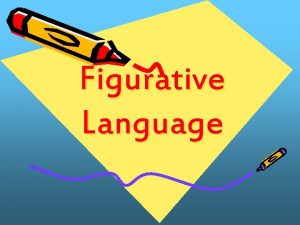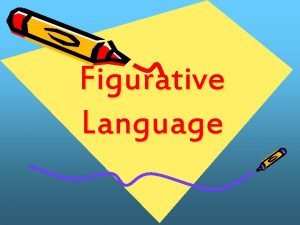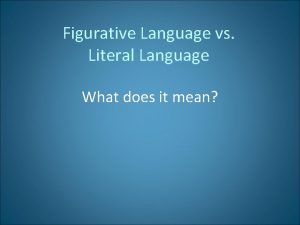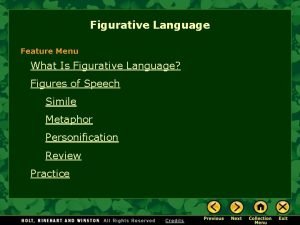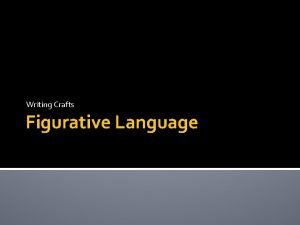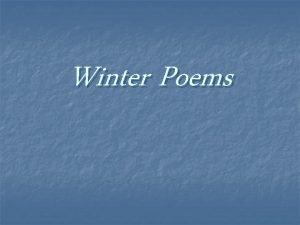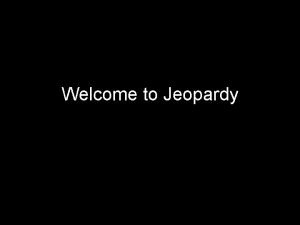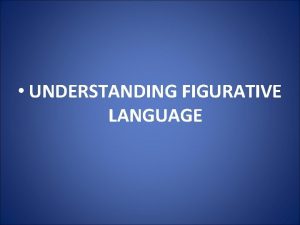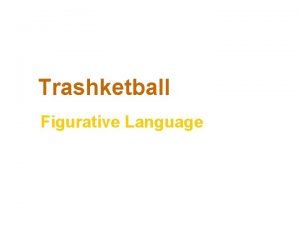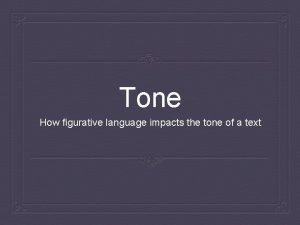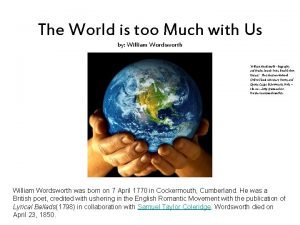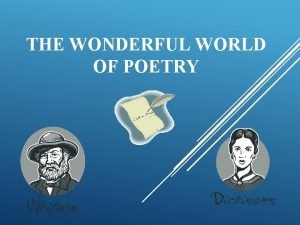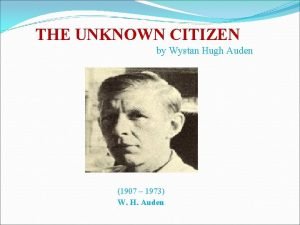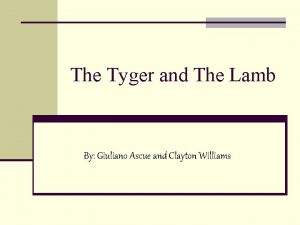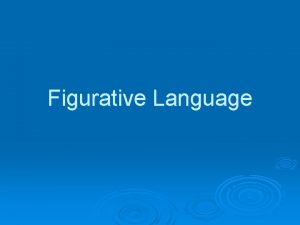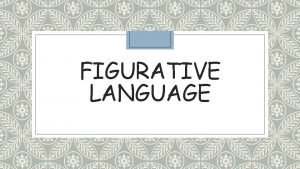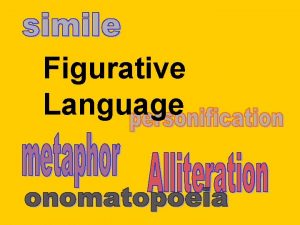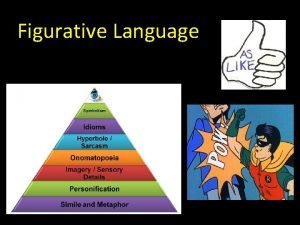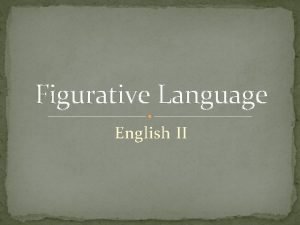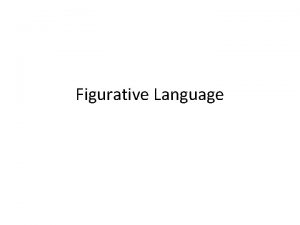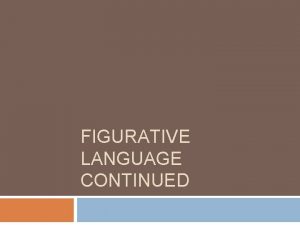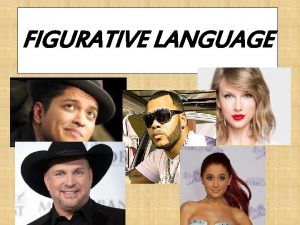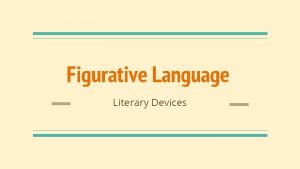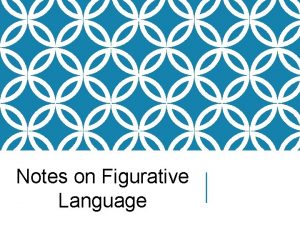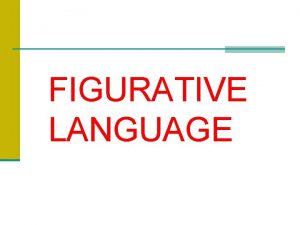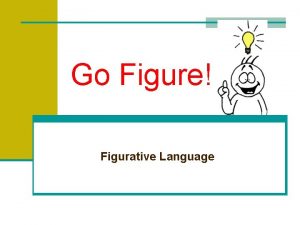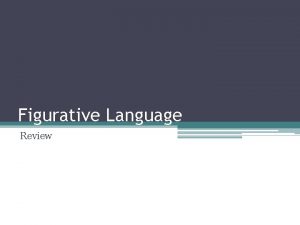FIGURATIVE LANGUAGE WHAT IS FIGURATIVE LANGUAGE Figurative Language

















- Slides: 17

FIGURATIVE LANGUAGE

WHAT IS FIGURATIVE LANGUAGE? • Figurative Language: words are used in an imaginative way to express ideas that are not literally true

TYPES OF FIGURATIVE LANGUAGE Simile Metaphor Personification Hyperbole Idiom Oxymoron Paradox Symbol Pun Allusion Onomatopoeia Irony

SIMILE • Simile: a figure of speech that makes a comparison between two unlike things using like or as • Examples: 1. Anna’s smile was like a welcoming 2. He was as scared as a cat. rainbow.

METAPHOR • Metaphor: a comparison of two things that are basically unlike but have some qualities in common • Examples: 1. He was a ghost moving among the guests. 2. New York City is a melting pot for different cultures in America.

PERSONIFICATION • Personification: giving human qualities to an animal, object, or idea • Examples: 1. The tree danced in the wind. 2. As I looked up in the night sky, the sparkling stars winked at me.

HYPERBOLE • Hyperbole: a figure of speech in which the truth is exaggerated for emphasis or humorous effect • Examples: 1. I was so exhausted I could sleep for one hundred days. 2. There were a million people at the dance tonight!

IDIOM • Idiom: an expression whose meaning cannot be determined by its literal expressions • Examples: 1. The boy decided to turn over a new leaf for this school year. 2. I am going to have to draw the line there; I will not do it.

OXYMORON • Oxymoron: a figure of speech made up of contradictory parts • Examples: Civil War Doing nothing Easy labor Good grief Hard cushion Minor crisis Quiet storm Upside down Well-preserved ruins

PARADOX • Paradox: a statement or situation that seems contradictory but reveals a truth • Examples: 1. This is the beginning of the end. 2. Don’t go near the water until you’ve learned to swim.

SYMBOL • Symbol: an object, character, or idea that is used to represent something else • Examples: Death Chinese

PUN • Pun: a play on words that are similar in sound but different in meaning; humorous • Examples: 1. I used to sell computer parts, but then I lost my drive. 2. I used to be a Velcro salesman, but couldn’t stick with it.

ALLUSION • Allusion: a reference to something outside the work in which it is found • Example: 1. John never spends any money. He is no Scrooge, but he rarely buys anything unless it is essential. John is being referred to Scrooge in A Christmas Carol by Dickens.

ONOMATOPOEIA • Onomatopoeia: the use of words whose sounds echo their meanings • Examples: Buzzzz… Moooo…

IRONY • Verbal Irony: the use of words to express the opposite of their literal meaning • Situational Irony: an outcome contrary to what was or might have been expected

PRACTICE ON YOUR OWN… Directions: Tell what type of figurative language is used in the following sentences. 1. The boy was a caged lion waiting to escape. 2. The rain tickled the leaves as it fell from the sky. 3. I am so hungry, I could eat a house! 4. The swan is as white as the snow falling. 5. Please don’t cry wolf too many times.

PRACTICE ON YOUR OWN… ANSWERS Directions: Tell what type of figurative language is used in the following sentences. 1. The boy was a caged lion waiting to escape. metaphor 2. The rain tickled the leaves as it fell from the sky. personification 3. I am so hungry, I could eat a house! hyperbole 4. The swan is as white as the snow falling. simile 5. Please don’t cry wolf too many times. idiom
 Literal vs figurative language
Literal vs figurative language Figurative language comic
Figurative language comic Figurative vs literal examples
Figurative vs literal examples Literal language and figurative language
Literal language and figurative language Figurative language and literal language examples
Figurative language and literal language examples Difference between idiom and hyperbole
Difference between idiom and hyperbole Is figurative language a language feature
Is figurative language a language feature The tell tale heart figurative language
The tell tale heart figurative language Personification for cold wind
Personification for cold wind Game language
Game language Ellipsis figurative language
Ellipsis figurative language Questions about figurative language
Questions about figurative language Trashketball directions
Trashketball directions Is tone figurative language
Is tone figurative language The world is too much with us symbolism
The world is too much with us symbolism Figurative language in the song what a wonderful world
Figurative language in the song what a wonderful world The unknown citizen author
The unknown citizen author Little lamb figurative language
Little lamb figurative language
